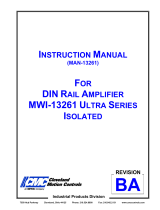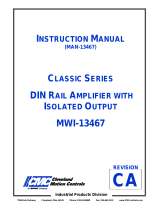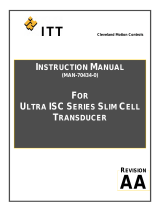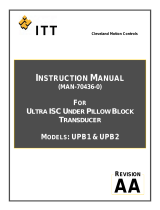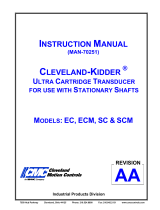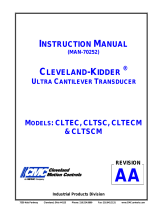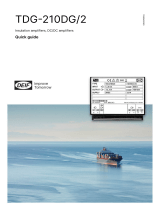Page is loading ...

I
NSTRUCTION
M
ANUAL
(MAN-13262)
F
OR
DIN
R
AIL
A
MPLIFIER
MWI-13262
U
LTRA
S
ERIES
N
ON
-I
SOLATED
7550 Hub Parkway Cleveland, Ohio 44125 Phone: 216.524.8800 Fax: 216.642.2131 www.cmccontrols.com
BA
REVISION
Industrial Products Division

DIN RAIL AMPLIFIER, MWI-13262 ULTRA SERIES MAN-13262 ULTRA REV BA
PAGE 2 OF 26
REVISION HISTORY
Rev ECO Author Date Description of Change
AA XXX DJM 01/19/04 As Released
BA CLE2912 DJM 08/12/04
Updated Block diagram, 4-20 mA section, Replaced
Transducer Wiring Diagram, Added Damped mA with
Scaling Board diagram.

MAN-13262
R
EV
BA
DIN
R
AIL
A
MPLIFIER
,
MWI-13262
U
LTRA
TABLE OF CONTENTS
1 P
RODUCT
O
VERVIEW
.................................................................................5
1.1
GENERAL DESCRIPTION .....................................................................................................5
1.1.1
CE EMC Responsibility .............................................................................................5
1.2
GENERAL SPECIFICATIONS.................................................................................................6
1.3
PHYSICAL SPECIFICATIONS ................................................................................................6
1.4
ENVIRONMENTAL REQUIREMENTS ......................................................................................7
1.5
OPERATING CONDITIONS ...................................................................................................7
1.6
EMC TECHNICAL RATINGS.................................................................................................7
1.7
EMISSION SPECIFICATIONS.................................................................................................7
2 S
ETUP AND
C
ONFIGURATION
......................................................................9
2.1
LOAD CELL (TRANSDUCER) TERMINALS..............................................................................9
2.2
POWER SUPPLY TERMINALS ..............................................................................................9
2.3
OUTPUT TERMINALS ..........................................................................................................9
2.4
RECOGNITION DIAGRAMS.................................................................................................10
2.5
CONFIGURING THE SWITCH SETTINGS ..............................................................................11
2.6
POTENTIOMETERS ...........................................................................................................12
2.7
EXCITATION VOLTAGE SELECT .........................................................................................12
2.8
CHANNEL SELECT............................................................................................................12
2.9
GAIN SELECT SWITCHES..................................................................................................13
2.10
METER VOLTAGE/CURRENT CONFIGURATION ................................................................13
2.11
METER OUTPUT DAMPING SELECT................................................................................13
2.12
WIRING ........................................................................................................................14
2.12.1
Wiring termination ...................................................................................................14
2.12.2
Transducer Wiring ...................................................................................................14
2.13
THE POWER SUPPLY ....................................................................................................15
2.13.1
Power Wiring diagram .............................................................................................15
2.13.2
Output wiring ...........................................................................................................15
3 P
OWER
-
UP AND
T
ESTING
.........................................................................19
3.1.1
Before Applying Power............................................................................................19
3.1.2
Power Application....................................................................................................20
3.2
TRANSDUCER POLARITY CHECK.......................................................................................20
3.3
A WORD ABOUT CALIBRATION .........................................................................................20
3.4
APPLYING FORCE TO TRANSDUCERS................................................................................21
3.5
ADJUSTMENT TOOLS........................................................................................................21
3.6
ADJUSTING AMPLIFIER COURSE ZERO..............................................................................22
3.7
ADJUSTING THE LCH-RCH BALANCE...............................................................................22
3.8
GAIN AND FINE ZERO CALIBRATION..................................................................................23
3.9
EMC CONNECTIONS AND INSTALLATION ...........................................................................24
A
PPENDIX
A. M
ANUFACTURERS
D
ECLARATION OF
C
ONFORMITY
...................25
A
PPENDIX
B. C
ABLE
G
LANDS
.....................................................................26
P
AGE
3
OF
26

DIN
R
AIL
A
MPLIFIER
,
MWI-13262
U
LTRA
S
ERIES
MAN-13262
U
LTRA
R
EV
BA
W
ARRANTY
Cleveland Motion Controls warrants the goods against defects in design, materials and workmanship for the period
of 12 months from the date of delivery on the terms detailed in the Cleveland Motion Controls, Inc. Terms and
Conditions of Sale, document number AO-90131
Cleveland Motion Controls, Inc. reserves the right to change the content and product specification without notice.
© 2003 in this document is reserved to:
Cleveland Motion Controls, Inc.
7550 Hub Parkway
Cleveland, OH 44125
216-524-8800 Phone
216-642-2199 Fax
I
NTENDED
U
SERS
This Instruction Manual is to be made available to all persons who are required to configure, install or service the
amplifier equipment described in this manual or any other related activity.
F
URTHER
I
NFORMATION
For the latest product information, technical literature etc., visit our website at www.cmccontrols.com
ATTENTION: The following information is provided merely as a guide for proper installation. Cleveland Motion
Controls cannot assume responsibility for the compliance (or failure to comply) to any code (national, local or other)
that prescribes the proper installation of this electronic device or associated equipment. A hazard of personal injury
and/or property damage can exist if applicable codes are not adhered to.
P
AGE
4
OF
26

MAN-13262
R
EV
BA
DIN
R
AIL
A
MPLIFIER
,
MWI-13262
U
LTRA
1 P
RODUCT
O
VERVIEW
1.1 G
ENERAL
D
ESCRIPTION
The Ultra Series DIN Rail amplifier (non-isolated) provides a complete signal conditioning solution for amplifying
and reporting signals from a pair of strain-gage-based load cells. Either semiconductor or foil-based load cells can
be used. Note that the non-isolated version of the Ultra Series DIN Rail amplifier shares the same ground reference
(common) between the 24VDC supply, output signals, and strain-gage bridge.
The Ultra Series DIN Rail amplifier uses a dedicated Instrumentation Amplifier (IA) for each transducer channel.
The IA stage amplifies the millivolt level signals generated by the load cells, while effectively rejecting common-
mode noise. A wide range of switch selectable gains can be used to provide the most appropriate level of initial
amplification. Low drift Surface Mount Technology (SMT) components, Multi-layer Printed Circuit Boards (PCB)
and optimum circuit topologies are incorporated to promote load cell signal integrity.
A summing amplifier stage combines the left and right IA channels. The gain of this stage is adjustable over a 10:1
range to allow span calibration of the analog outputs. To improve rejection of “out of band” signals, the summing
stage is followed by a DC accurate 2-pole active filter.
A precision voltage source is provided for exciting the strain gage elements in the inter-connected load cells (tension
transducers). The circuit includes a short circuit current limit feature to protect the amplifier in the event of mis-
wiring. Output voltage is selectable to either of the following:
• 5.0 VDC
• 10.0 VDC
The final analog tension signal is available in a variety of forms. The un-damped output signal can be provided
from a +/-10V analog buffer stage, as well as a standard 4-20 mA current loop stage. The voltage supply for the
current loop bias is internally provided. The current loop scaling has been specially designed so that minor negative
excursions of the tension signal can continue to be reported as currents below 4 mA.
A damped (low pass filtered) version of the tension signal is available for driving displays or recording devices. The
damping is switch selectable for a cutoff frequency of either 0.3 Hz or 3.7 Hz. Damping is useful for improving the
readability, effectively masking higher frequency fluctuations superimposed on the tension signal. This damped
output stage can be configured to be either:
• +/- 2V analog output - intended primarily for driving Digital Panel Meters (DPM).
• +/-1 mA current source - When configured as the current source, the 1 mA output is
typically used to drive D’Arsonval style analog meters.
1.1.1 CE EMC RESPONSIBILITY
Cleveland Motion Controls DIN Rail Amplifier MWI-13262 Ultra Series module can be considered a component
performing a direct function and therefore is subject to the provisions of the EMC Directive.
The Cleveland Motion Controls DIN Rail Amplifier MWI-13262 module may be used by a manufacturer as a
component of a larger system, along with other components, which may or may not bear the CE mark. The system
assembler is responsible for the compliance of the system as a whole with the EMC Directive.
To assist manufacturers, suppliers, and installers of relevant apparatus, the Cleveland Motion Controls DIN Rail
Amplifier MWI-13262 module is compliant to EN61326:1997 when installed according to these instructions.
Manufacturers, suppliers, and installers of relevant apparatus may use this compliance as a contributing basis for
their own justification of overall compliance with the EMC Directive.
Before installing the Ultra Series DIN Rail Amplifier you must clearly understand who is legally responsible for
conformance with the EMC Directive. Misappropriation of the CE mark is a criminal offense.
P
AGE
5
OF
26

DIN
R
AIL
A
MPLIFIER
,
MWI-13262
U
LTRA
S
ERIES
MAN-13262
U
LTRA
R
EV
BA
1.2 G
ENERAL
S
PECIFICATIONS
Item Specification Comments
Input Supply
Power Supply Requirements 24 VDC @ 160 milliAmps Basic Non-Isolated Amplifier
Power Supply Limits 20 to 28 VDC Basic Non-Isolated Amplifier
Load Cell (Transducer)
Transducer Excitation (Vexc) 5.0 or 10.0 VDC Shipped with V EXC. Set at 5.0 VDC.
100milliAmp maximum.
Switchable to 10 VDC with internal
switch.
Transducer Resistance Range 100 to 1000 Ohms Do not exceed maximum excitation
current.
Transducer Gage Types Semi-Conductor (20-100 mV/V) or
Foil (2-3 mV/V)
Gain switches configure each input
gain from 5 to 620 as needed, to
amplify transducer voltage.
Amplifier
Input Impedance 10K (Line-Line) Nominal Inputs may be used single ended or
together as a differential pair
Selectable Gains, IA stage 8, 30, 120, 500 Gains switched by referring to section
2.5 in this document.
Calibration Range, summing
stage
Min. 0.9 - Max. 9 Multi-turn Gain adjustment provided.
Zero Range +/- Full Scale Output Coarse adjustments for each channel
provided. Fine adjustment affects
sum.
Nominal Input Signal Levels 0-500 milliVolts
0-20 milliVolts
Each semi-conductor load cell
Each foil-gage load cell
Pulse Response 10-90% Stop,
0-10V and 4-20 mA
300 milliseconds for undamped
signals
Amplifier Output Signal +/-10 VDC @ 2 mA
4-20 mA current loop
0-2 VDC @ 2 mA
+/- 1milliAmp
+/-10 is undamped signal
Current loop undamp
+/- 2VDC signal (or 1mA) has switch
selectable damping (0.3 or 3.7 Hz)
1.3 P
HYSICAL
S
PECIFICATIONS
Item Specification Comments
Enclosure Type
DIN Rail mountable with main user
adjustments accessible from front
surface. Snap-on cover to access
configuration switches and setup
potentiometers.
Phoenix EG type ABS enclosure. Color green.
Enclosure Size Base: 45 mm wide by 75 mm high
Depth: 105 mm
1.8 inches (width) by 3.0 inches (height)
4.2 inches (depth)
Weight – Basic Amplifier 170 Grams 6 ounces
Terminals
Two removable plugs of eight
terminals each, keyed to avoid mis-
plugging
Screw type terminals, will accept up to one 12
AWG or equivalent.
Phoenix “Combicon” type.
P
AGE
6
OF
26

MAN-13262
R
EV
BA
DIN
R
AIL
A
MPLIFIER
,
MWI-13262
U
LTRA
1.4 E
NVIRONMENTAL
R
EQUIREMENTS
Requirement Description
Enclosure IP20
NEMA 1
Operating temperature 0 to 55 degrees C
32 to 132 degrees F
Humidity
Non-condensing
85% at 55 degrees C
85% at 132 degrees F
Altitude 1000 meters
3300 feet
Atmosphere Non-flammable, non-corrosive and dust free
Storage temperature range -25 to 80 degrees C
-13 to 176 degrees F
Transport temperature range -25 to 80 degrees C
-13 to 176 degrees F
1.5 O
PERATING
C
ONDITIONS
Condition Ultra Series DIN Rail amplifier
Installation category Category III
Pollution Pollution Degree 2
Input supply Earth (Ground) referenced
Protection Enclosure mounted
1.6 EMC
T
ECHNICAL
R
ATINGS
Port Phenomenon Test Standard Level Test Standard
Enclosure ESD EN 61000-4-2: 8KV AD, 1KV CD EN 61326:1997
Enclosure RF Field EN 61000-4-3 10V/m,1 Khz AM EN 61326:1997
Transducer Leads Fast Transient
Burst EN 61000-4-4 1kV EN 61326:1997
Output Leads Fast Transient
Burst EN 61000-4-4 1kV EN 61326:1997
Transducer Leads Conducted
Immunity EN 61000-4-6 3V/m EN 61326:1997
Output Leads Conducted
Immunity EN 61000-4-6 3V/m EN 61326:1997
AC Power Line Surge EN 61000-4-5 +/-2KV L to PE
+/-1KV L to L EN 61326:1997
AC Power Line Voltage Dips EN 61000-4-11 +/-0.5 Cycle
100% EN 61326:1997
1.7 E
MISSION SPECIFICATIONS
Port Phenomenon Test Standard Level Generic Standard
Enclosure Radiated EN 61326:
1997
Class A EN 61326:1997
The levels of performance indicated are achieved when the Ultra Series DIN Rail Amplifier is
installed by using the instructions and specifications outlined in this document.
P
AGE
7
OF
26

DIN
R
AIL
A
MPLIFIER
,
MWI-13262
U
LTRA
S
ERIES
MAN-13262
U
LTRA
R
EV
BA
Figure 1 - Block Diagram of Ultra Series DIN RAIL MWI -13262
P
AGE
8
OF
26

MAN-13262
R
EV
BA
DIN
R
AIL
A
MPLIFIER
,
MWI-13262
U
LTRA
2 S
ETUP AND
C
ONFIGURATION
2.1 L
OAD
C
ELL
(T
RANSDUCER
)
T
ERMINALS
Terminal Function Description Notes
EXC RET Supply return for bridge
excitation
Zero voltage terminal for
LCH and RCH transducers COMMON
+V EXC Bridge excitation source for
LCH and RCH transducers 5.0 Volt or 10.0 Volt supply terminal, max. load 100 mA
-IN LCH Load cell signal from LCH
transducer
Low going output from LCH
transducer 10K ohm line-to-line
+IN LCH Load cell signal from LCH
transducer
High going output from LCH
transducer
-IN RCH Load cell signal from RCH
transducer
LOW going output from RCH
transducer 10K ohm line-to-line
+IN RCH Load cell signal from RCH
transducer
High going output from RCH
transducer
OPEN (N.C.) NO CONNECTION Make no connection
SHLD DRN Cable shield
drain terminal
Cable Shield for LCH and RCH
transducer cables Connect only at amplifier
Transducers (load cells) use strain gages which have limited insulation levels to ground (earth).
This requires that the COM terminals be connected to ground (earth) to prevent damage to the
transducers (load cells).
2.2 P
OWER
S
UPPLY
T
ERMINALS
Output Terminal Function Description Notes
J2-1 24V RET Power Supply Power supply return Must not exceed 50 volts
from P.E.
J2-2 +24 VDC Power Supply Positive supply source +20 to +28 VDC
@ 160 mA max
A fuse with a rating of 0.38A must be used in the 24 VDC supply lead to limit potential
damage to the amplifier in the event of circuit malfunction.
2.3 O
UTPUT
T
ERMINALS
Output Terminal Function Description Notes
J2-3 COMMON Output signal return
Common for +/- 10V and
+/-2V output
J2-4 +/- 10V OUT Voltage Output signal Undamped bi-polar
tension signal max. load 2 mA
J2-5 mA MTR RET mA meter signal Used for current format meter
return
Current through 1 mA
meter returns here
J2-6 METER OUT Output signal Damped bi-polar tension
signal
Switchable 2.0 V F.S.
or 1 mA F.S.
J2-7 4-20mA OUT Current loop Output
signal
Undamped tension signal,
current loop source Internal Loop supply
J2-8 4-20mA RET Output current signal Current return for
4-20 mA loop
At -15 VDC with respect to
common
P
AGE
9
OF
26

DIN
R
AIL
A
MPLIFIER
,
MWI-13262
U
LTRA
S
ERIES
MAN-13262
U
LTRA
R
EV
BA
2.4 R
ECOGNITION
D
IAGRAMS
DIAGRAM
1.999
WIRING
Power Supply
Terminals
Output
Terminals
RIGHT SIDE VIEWLEFT SIDE VIEW
FRONT VIEW
Terminals
Transducer
LINE LOAD CELL AMPLIFIER
CMC PART NUMBER: MWI-13262
WITH NON-ISOLATED OUPUTS
WWW.CMCCONTROLS.COM
Figure 2– Front and Side Views of Ultra Series DIN Rail Amplifier MWI 13262
Figure 3 - Ultra Series DIN Rail Amplifier Mounting Diagram
P
AGE
10
OF
26

MAN-13262
R
EV
BA
DIN
R
AIL
A
MPLIFIER
,
MWI-13262
U
LTRA
J1
Figure 4 - Internal Jumper-switches and Potentiometer Location
2.5 C
ONFIGURING THE
S
WITCH
S
ETTINGS
A number of operational characteristics can be configured prior to mounting or wiring the amplifier. We
recommended that you first familiarize yourself with the internal switch locations, settings, and potentiometers by
opening the snap-on access cover. Figure 4 illustrates the location of configurable items on each of the printed
circuit boards.
Use an approved anti-static wrist strap when adjusting any switch settings/potentiometers on the amplifier.
Switch PCB Location Function
J3
Input Configures Excitation voltage for 5.0 or 10.0 VDC. The amplifier is factory set at (setting 1-2 ) for
5.0V
J8
Input
Selects left channel only (setting 2-3) or LCH + RCH (setting 1-2) as input to summing amplifier
stage. Slide the jumper switch to (1-2) for normal operation with two transducers. Refer to
setup/calibration section for more information.
J1
Input
Connects completion resistances of RCH transducer input to ½ of excitation voltage
(setting 1-2). Slide the jumper switch to setting (2-3) for normal operation with Ultra Full-Bridge
transducers. Slide jumper switch to setting (1-2) if the channel is unused.
J2
Input
Connects Completion resistances of LCH transducer input to ½ of excitation voltage
(setting 1-2). Slide the jumper switch to setting (2-3) for normal operation with Ultra Full-Bridge. Slide
the jumper switch to setting (1-2 ) if the channel is unused.
J10
J9
J7
Input
Sets voltage gain of LCH Instrumentation amplifier to 5, 25, 125 or 620. The jumper switches are
factory set to (1-2) for minimum gain (Av = 5). Refer to section 2.9 for more information on setting
Gain select switches.
J6
J5
J4
Input
Sets the fixed gain of RCH Instrumentation amplifier. The jumper switches are factory set to
(1-2) for minimum gain (Av=8).
J1
Output
Configures meter output stage for +/- 2V F.S. or +/- 1 mA F.S. The jumper switch is factory set to (1-
2 ) for voltage output. Voltage and current modes use different terminals.
J2
Output
Selects meter damping 0.3 Hz or 3.7 Hz. The jumper switch is set to (2-3) for minimum damping. (3.7
Hz)
Output
Board
J10 J9 J7 J5
J6
J4
P5
LCH Course
Zero
P4
Balance
P3
RCH Course
Zero
Input
Board
J2
J1
J8
Channel
Select
J3 J2
LCH Gain
RCH Gain
P
AGE
11
OF
26

DIN
R
AIL
A
MPLIFIER
,
MWI-13262
U
LTRA
S
ERIES
MAN-13262
U
LTRA
R
EV
BA
2.6 P
OTENTIOMETERS
In addition to the Gain and Zero adjustable Potentiometers visible on the front of the unit, there are adjusts you can
make by removing the snap-off cover on the side of the amplifier. The adjustments are on the output and input
printed circuit boards as shown in Figure 4. The following table provides you with a list of Potentiometers, where
they are located on the Ultra Series DIN Rail input printed circuit board, and a description of their functions.
Potentiometer Reference
Designator Location Function
GAIN P2 Unit Front
Provides 10:1 “vernier” adjustment of the summing amplifier. It is a multi-
turn potentiometer, with clockwise rotation causing an increase in amplifier
gain. When turned fully counter clockwise, the potentiometer will cause the
summing amplifier stage to provide the minimum gain of 0.9.
ZERO P1 Unit Front
Provides a fine zero (offset) adjustment. It simultaneously and equally
affects both of the instrumentation amplifiers. It is a multi-turn
potentiometer, with clockwise rotation causing a positive shift in the analog
outputs. It should be set mid-way prior to setting the COARSE ZERO
adjustment.
LCH Coarse
Zero P5 Input, behind
access cover
Establishes the coarse zero of the Left Channel (LCH) instrumentation
amplifier. Because of the ability to cause +/- Full scale (+/- F.S.) output
shifts, it is important to correctly follow the final set-up and calibration
procedure so that premature amplifier “clipping” is avoided
RCH Coarse
Zero P3
Input PCB,
behind access
cover
Establishes the coarse zero of the Right Channel (RCH) instrumentation
amplifier. Because of the ability to cause +/- Full scale (+/- F.S.) output
shifts, it is important to correctly follow the final set-up and calibration
procedure so that premature amplifier “clipping” is avoided. This is a multi-
turn adjustment potentiometer.
LCH-RCH
Balance P4
Input PCB,
behind access
cover
Allows for matching (balancing) the gain between transducers if needed.
Don’t adjust this unnecessarily; it has been factory set for equal balance.
Turning clockwise boosts the signal for the Left Channel. This multi-turn
adjustment potentiometer has been deliberately “set back” from the
adjacent ZERO potentiometers to discourage accidental adjustment.
2.7 E
XCITATION
V
OLTAGE
S
ELECT
The Excitation Voltage is determined by the position of jumper switch J3. Refer to Figure 4 for Jumper-switch
locations. The jumper default setting is J3 (1-2) for 5.00V excitation Do not use 10V setting J3 (2-3) unless
explicitly permitted by the load cell electrical specifications. Promptly verify the excitation voltage after power-up
to avoid overdriving strain gages. Note that if there is no external load resistance, the voltage may rise to 6.4V, but
will immediately regulate at 5.00V when the load cells are connected.
Keep in mind that the strain gage based load cells can readily operate at less than rated voltage (with a
corresponding reduction in output signal). This fact is helpful in the event that a “10 V “ load cell exhibits an output
signal that is excessive for even the lowest amplifier gain.
2.8 C
HANNEL
S
ELECT
Jumper-switch J8 configures the inputs to the Variable Gain Summing Amplifier stage. For most applications
involving a pair of transducers, it is placed in the J8 (1-2) position so that the analog outputs represent the sum of the
left and right channels (LCH + RCH). During portions of the calibration procedure, or if only the left transducer
channel is utilized, it is placed in the J8 (2-3) position. In this position, the signals at the analog outputs represent
only the left channel (LCH).
P
AGE
12
OF
26

MAN-13262
R
EV
BA
DIN
R
AIL
A
MPLIFIER
,
MWI-13262
U
LTRA
2.9 G
AIN
S
ELECT
S
WITCHES
The group of jumper-switches that control the fixed gain of the Instrumentation Amplifiers (IA) are located closest
to the front left edge of the Input card. (Refer to Figure 4) Typically, you configure both channels to the same setting
if both transducers are the same force rating.
When the amplifier is held horizontally with the pluggable connectors facing toward the right (refer to Figure 4), the
leftmost cluster (J10, J9, J7) sets the gain for the LCH (Left Channel) Instrumentation Amplifier. Similarly, the
right cluster (J6, J5 and J4) sets the gain for the RCH (Right Channel) Instrumentation Amplifier. The lowest gain
(Av = 8) occurs when all of the switches are in the 1-2 position. As switches are moved “away” (into position 2-3)
from left to right, the gain progressively increases as described in following table:
Left Channel
J10 J9 J7 Voltage Gain Right Channel
J6 J5 J4
1-2 1-2 1-2 5 1-2 1-2 1-2
2-3 1-2 1-2 25 2-3 1-2 1-2
2-3 2-3 1-2 125 2-3 2-3 1-2
2-3 2-3 2-3 620 2-3 2-3 2-3
When changing the internal Jumper-switch settings, it is always advisable to change the settings
with the 24 VDC power removed. If this is not possible, it becomes particularly important to use
a non-conductive tool to alter switch positions.
Make sure that Jumper- switch settings are fully in position to avoid accidentally leaving a switch in an “in-
between” state.
The total gain range of the amplifier is the product of the IA and summing amplifier gains (variable).
Using the lowest gain switch settings, the net gain is 5 x (.9 to 9.0 ) or 4.5 to 45
With the other gain combinations available, a 10 volt output can be produced with input voltages ranging from
between 0.002 to 0.50 volts.
2.10 M
ETER
V
OLTAGE
/C
URRENT
C
ONFIGURATION
The damped output for a tension indicator can be configured as either a +/- 2V output or a +/- 1mA output by
changing the position of jumper-switch J1 located on the Output Card (Refer to Figure 4 for location). Voltage
output is selected by setting J2 (1-2). Current output is selected when J2 (2-3 ). Note that different wiring terminals
are employed for the signal return when configured for current or voltage.
2.11 M
ETER
O
UTPUT
D
AMPING
S
ELECT
The amount of damping for the meter output (intended to drive a tension indicator) can be configured by the position
of jumper-switch J2 on the Output card (refer to Figure 4 for location information). Setting the jumper switch to J2
(1-2) sets the break frequency at 0.3 Hz. Setting the jumper switch to J2 (2-3), the break frequency setting is raised
to 3.7 Hz
P
AGE
13
OF
26

DIN
R
AIL
A
MPLIFIER
,
MWI-13262
U
LTRA
S
ERIES
MAN-13262
U
LTRA
R
EV
BA
2.12 W
IRING
Most start-up problems are the result of mis-wiring or failure to reference the detailed information in this manual.
While a convenient basic wiring diagram can be found printed on the side label of the amplifier case, the diagram is
intended only as a helpful guide when checking field wiring. Additional information details can be found in the
subsequent sections of this manual and should be referenced before actual installation begins.
2.12.1 WIRING TERMINATION
Terminal(s) Conductor Size Insulation Strip Length Torque Notes
All
1.5mm
2
/16 AWG
0.75mm
2
/18AWG
0.5mm
2
/20AWG
7 mm ( 0.28” )
7 mm ( 0.28” )
7 mm ( 0.28” )
0.5 Nm / 4.4 lbs.-in.
0.5 Nm / 4.4 lbs.-in.
0.5 Nm / 4.4 lbs.-in.
One wire this size per terminal
Up to two wires this size per terminal
Up to two wires this size per terminal
2.12.2 TRANSDUCER WIRING
LEFT XDCR
8
7
6
345
2
1
123
BLK
WHT
BLU
BRN
6
5
48
7
WHT
BLU
BLK
BRN
1
1
2
3
4
2
3
4
RIGHT XDCR
CT
TC
CT
TC
Figure 5 - Full-bridge Transducer Wiring
The successful amplification of low level signals from strain gage transducers requires particular attention to wiring
practices to avoid signal degradation in the industrial environment. Degradation can result from AC noise pickup
and/or DC errors. Refer to the following guidelines to identify measures that may help retain signal quality:
• Use Ultra Series shielded transducer cables to reduce pickup of noise through electrostatic coupling.
• Route cables away from sources of electrical interference (motor wiring, contactors, etc).
• Connect the shield drain wire at one end only to discourage shield currents.
• Optimum high frequency grounding requires low inductance connections that are enhanced with short
conductors or planar ground conductors (wide ground braids).
• Do not pre-tin the stranded wires inserted into the pluggable connector.
• A stable connection relies on the springy nature of stranded conductors to ensure a low contact
resistance despite thermal cycling and airborne impurities.
• Avoid temperature extremes or gradients where electrical connections are made between different
metals. Connections can cause thermocouple voltages to be generated, which then become
superimposed on transducer signals.
• In severe cases, additional shielding may be required in the form of either external flexible braided
shields or running the field wiring wires inside metallic conduit.
P
AGE
14
OF
26

MAN-13262
R
EV
BA
DIN
R
AIL
A
MPLIFIER
,
MWI-13262
U
LTRA
2.13 T
HE
P
OWER
S
UPPLY
For best performance a regulated power supply should be used with the Ultra Series DIN Rail amplifier. It is
important that you pay particular attention to the power supply for susceptibility to the effects of conducted and
radiated energy from noise sources. Every effort should be made to provide stable voltage to the amplifier using
correct wiring practices and filters. To protect against circuit damage, include a 0.38 Amp fuse in the power supply
output lead to each amplifier in case of amplifier or power supply malfunction.
2.13.1 POWER WIRING DIAGRAM
The 0.38 A fuse in the +24VDC power lead is required for protection of the amplifier in the event of amplifier or
power supply malfunction.
8
7
56
34
2
1
12346
578
+24 V
0 V
FUSE
24 Vdc
POWER
SUPPLY
Figure 6 - Wiring diagram for use with 24 VDC power supply
The power source for the power supply shall be fused at the proper rating to prevent over current in
the supply leads due to a power supply failure.
2.13.2 OUTPUT WIRING
The load in this connection may be an indicator, recorder, data acquisition device or the analog input terminals of a
control device such as a DC drive or a programmable logic controller. The output signal at this terminal is
undamped and is the output terminal that provides that fastest response to changes in the transducer (load-cell) load.
Note that the cable’s shield drain wire should be connected at only one end, preferably at the “receiving end”.
8
7
12
356
4
2
1
6
4
3578
SHIELD GND
RESISTANCE
5000 OHM MIN
+ / - 10V LOAD +
Figure 7 - Output Wiring, +/- 10V Analog
P
AGE
15
OF
26

DIN
R
AIL
A
MPLIFIER
,
MWI-13262
U
LTRA
S
ERIES
MAN-13262
U
LTRA
R
EV
BA
2.13.2.1 4
TO
20
M
A
A
NALOG
C
URRENT
L
OOP
The 4-20 mA current loop output is undamped and can be used concurrently with the other outputs. The 20 mA
current level corresponds to the +10V output. The 4 mA level corresponds to 0 volts on the 10V output.
This output does not have an individual Gain and Zero Potentiometer adjustment. If multiple types of analog output
are being used, a compromise must be made during calibration, or a particular output be favored (over one that can
best accommodate individual external scaling and offsetting).
The bias supply to drive the current loop is provided internally by the Ultra amplifier. External burden resistance
(loop resistance) can range between 50 and 750 ohms.
The circuitry which drives the current loop is essentially a linear regulator stage. This means that internal power
dissipation (hence temperature rise) is lessened when higher values of external burden resistance are used.
Moderate values of burden resistance can be strategically employed to minimize internal temperature rise (and
thereby minimize amplifier drift in sensitive applications).
78
46
5
13
2
25
34
18
67
LOOP RESISTANCE
SHIELD GND
+
4 to 20 mA
i
+
50 - 750 OHMS
Figure 8 - Output Wiring, 4 to 20 mA Analog Current Loop, Floating Burden
P
AGE
16
OF
26

MAN-13262
R
EV
BA
DIN
R
AIL
A
MPLIFIER
,
MWI-13262
U
LTRA
2.13.2.2 A
PPLICATION
I
NTERFACE DETAILS
The 4-20 mA output stage is designed to drive a loop current through a floating burden resistance. Examples of
driving a loop current through a floating burden resistance include: a loop powered 4-20 mA display or, the isolated
input of receiving electronics (isolated Analog to Digital input). The 4-20 mA output can also drive non-isolated (or
ground referred) burden resistances provided that the circuit that employs the burden does not connect to the isolated
common (COM, J2-3) of the amplifier.
For a better understanding as to why the burden must be floating with respect to the amplifier’s isolated common
(COM, J2-3) refer to Figure 9. This figure illustrates that the 4-20 mA OUT (J2-7) is connected to the +15V internal
supply voltage and the 4-20mA RET terminal sinks loop current toward the -15V internal supply. A truly floating
burden receives the loop current that is controlled by the amount of current sinking into the -15V supply. The
current is supplied by the +15V supply. Incorrectly connecting burden resistance between the 4 -20mA OUT and
COM (J2-3) would cause excessive current to flow. Incorrectly connecting the 4-20mA RET (J2-8) to COM (J2-3)
results in the 4-20mA current being drawn from ground and bypassing the burden resistance.
Figure 9 – 4-20 mA Output Circuit Wired for Floating Burden
While it is possible to interface the 4-20 mA current loop into circuits which do exhibit resistances between their
burden and the amplifier isolated COM, (Refer to Figure 10.), this is a less desirable configuration. If you chose to
wire the amplifier in this way, you must keep the following in mind. When the commons of both circuits are
connected, be sure that the amplifier’s 4-20 mA OUT remains unconnected and that the 4-20 mA RET (J2-8) is
connected to draw loop current from a ground referred burden resistance at the receiving circuit. The burden
resistance must not exceed 250 Ohms due to the reduced bias voltage, however a full-scale signal of -5.0 VDC is
still possible (-5V= -20 mA x 250 Ohms).
P
AGE
17
OF
26

DIN
R
AIL
A
MPLIFIER
,
MWI-13262
U
LTRA
S
ERIES
MAN-13262
U
LTRA
R
EV
BA
4 to 20 mA
SHIELD GND
LOOP RESISTANCE
+
i
+
5
48
567
14
3
2
23
1
8
7
6
50 - 250 OHMS
Figure 10 – 4-20 mA Output Wiring for Ground Referred Burden
2.13.2.3 D
IGITAL
V
OLTMETER
The +/- output terminal is designed to provide +2.0 volts when the +/- 10 V output terminal is adjusted (with the
Gain and Zero pots) to be +10.0 volts (this is full scale). To achieve different scaling, adjust gains on the Digital
Panel meter (DPM).
DIGITAL VOLT METER
+
78
2
1
346
5
12
8
7
5
346
0 TO 1.99 VOLT
MINIMUM METER RESISTANCE = 2000 OHMS
Figure 11
-
Output Wiring, Damped +/- 2V Analog
P
AGE
18
OF
26

MAN-13262
R
EV
BA
DIN
R
AIL
A
MPLIFIER
,
MWI-13262
U
LTRA
2.13.2.4 D
AMPED
+/-
1
M
A
A
NALOG
The meter output stage can be configured to operate as current output (sinking or sourcing current depending upon
output polarity). It can be used concurrently with the other outputs. It does not have an individual Gain and Zero
adjustment, necessitating that a compromise be made during calibration, or a particular output be favored (over one
that can accommodate external scaling and offsetting).
To facilitate individual scaling of the analog meter a panel meter (MO-13655) with scaling board, is available as
an accessory for use with Ultra Series tension transducer amplifiers. The scaling board lets the analog meter
have a different scaling factor than that of the main (un-damped) analog output.
MAXIMUM METER RESISTANCE = 7K OHMS
1mA
1
4
3
2+
Figure 12 - Output Wiring, Damped mA Analog with Scaling Board
3 P
OWER
-
UP AND
T
ESTING
3.1.1 BEFORE APPLYING POWER
Before applying power, check the wiring to the amplifier. Pay particular attention to the following:
• Double check the transducer connections to ensure that the excitation supply is not short-
circuited.
• Use an approved anti-static wrist strap when adjusting any switch settings/potentiometers on the
amplifier.
• Use the appropriate tool when making any adjustments to the potentiometers on the amplifier or
changing switch settings. Damage to the circuitry may occur if excessive force is used or a
conductive tool accidentally contacts internal voltages.
Before applying power, confirm that the zero potentiometers are mid-span and the gain is minimum. Use the
following table to adjust potentiometers:
Adjustment Potentiometer Default
Gain – P2 Full counter-clockwise
Zero – P1 Mid-way (9 turns from full counter-clockwise)
LCH – course zero Mid-way (6 turns from full counter-clockwise)
RCH – course zero Mid-way (6 turns from full counter-clockwise)
P
AGE
19
OF
26

DIN
R
AIL
A
MPLIFIER
,
MWI-13262
U
LTRA
S
ERIES
MAN-13262
U
LTRA
R
EV
BA
3.1.2 POWER APPLICATION
Apply DC power to the amplifier and use a DC voltmeter to confirm that the supply polarity and voltage is within
the prescribed limits. As soon as is practical, confirm that the excitation voltage is either 5.0 VDC or 10.0 VDC as
appropriate for the type of load cells being used. Promptly identifying any over-voltage condition can help
minimize potential damage to the strain gage elements internal to the transducer. Note that the excitation voltage
may rise to approximately 6.5 VDC if the amplifier is operated without any transducers attached. This voltage will
return to the precisely regulated value when the transducer load is connected.
3.2 T
RANSDUCER
P
OLARITY
C
HECK
This step is important in identifying transducer or wiring problems early-on in the setup procedure. Information
learned in this check will be instrumental in setting the optimum gains for the Left and Right Instrumentation
Amplifier stages. The following steps described the polarity check only for the Left Channel (LCH), but the steps
are applicable to the Right Channel (RCH) as well.
1. Measure the -LCH load cell signal with a digital volt meter (DVM) at the input to the amplifier with respect
to the Excitation Return (EXC RET) to confirm that it is roughly 58% of the excitation voltage.
Measure the +LCH signal to confirm that it is roughly 58% of the excitation voltage.
If both measurements are less than 50% of the excitation voltage, then it is likely that the BLU and BRN
transducer cable leads have been mis-wired.
2. Measure the voltage at the +LCH input to confirm that it becomes more positive when a small trial force is
applied in the transducer’s intended force direction. The –LCH input should become less positive when the
same force is again applied. If the “sense” of this voltage change is incorrect for the way the transducer is
mounted, interchange the load cells wiring for –LCH and +LCH signals.
Without a calibration force applied to the load cells, measure the “UNLOADED” DC voltage difference
between the LCH+ and –LCH signals. Use the lowest practical voltmeter scale to provide a meaningful
measurement. Remember or record this measured value for later use.
3. Apply the intended full scale force to the load cell and measure the “LOADED” voltage.
Both of these voltages, as well as the difference between these two voltages, help to indicate the best Gain
setting configuration at the first amplification stage. Select the highest possible gain for the first stage that
does not result in saturation (“clipping”) of the transducer signal. If the voltages do not exceed 180mV,
then a gain of 25 is appropriate. Similarly, a lower signal of 35mV could use a higher gain of 125.
4. Set the IA gains using the Jumper-Switches (refer to section 2.9). We recommend using the same gain
setting for both the LCH and RCH, consistent with the requirement of avoiding saturation.
3.3 A
W
ORD
A
BOUT
C
ALIBRATION
This section describes the calibration process for establishing particular voltages at the +/- 10V analog output. If
you intend to use the 4-20 mA output, then make that output the focus of your calibration efforts. Similarly,
calibrate to the meter output if that is your primary focus.
P
AGE
20
OF
26
/
